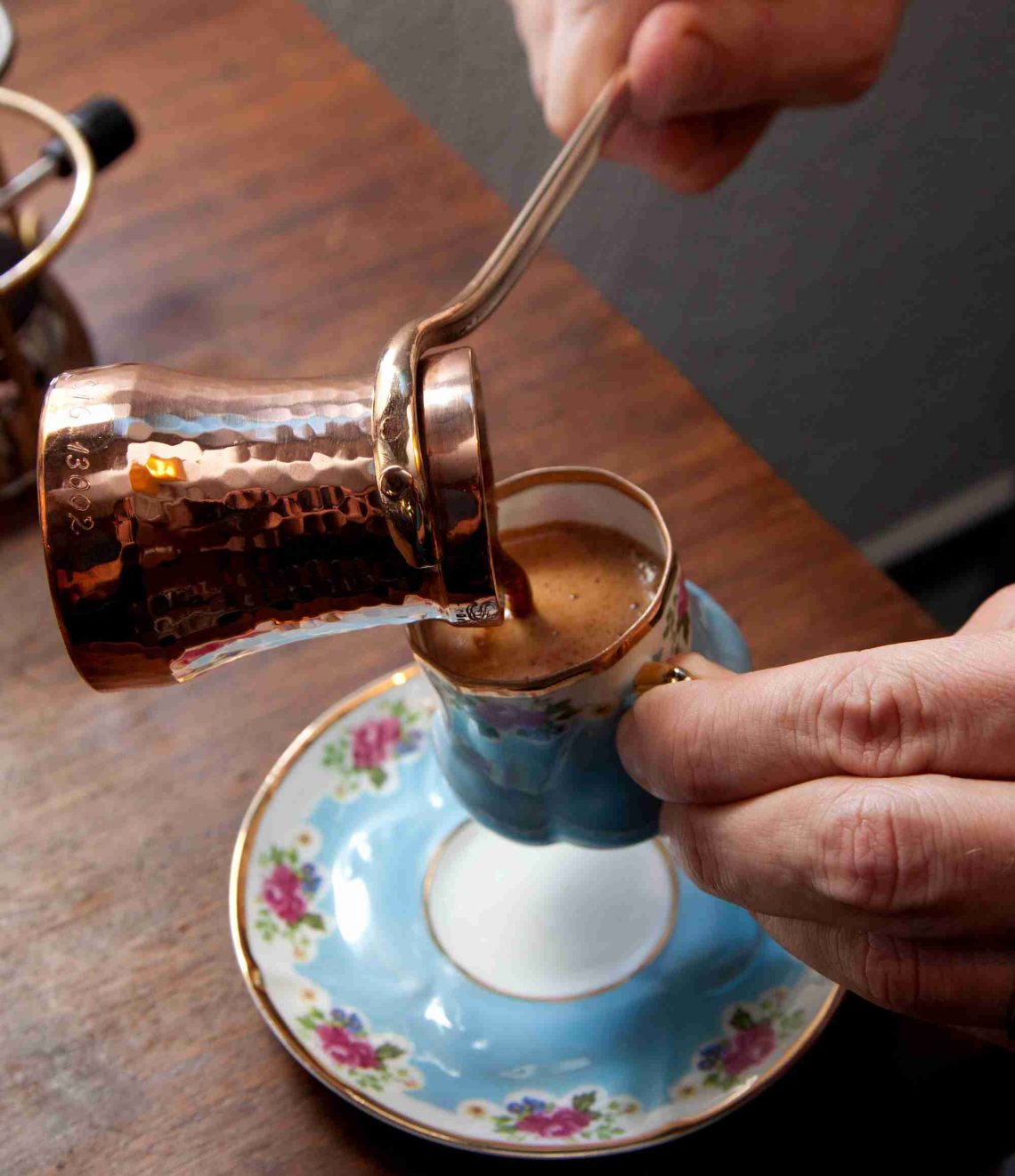
Turk Kahvesi (Turkish coffee): Preparation, Origin & History
Coffee (Turk Kahvesi) has a long tradition in Turkey.
The first coffee house in Europe opened in Istanbul in 1554.
Due to its long history, Turkish coffee (Türk kahvesi) is on the UNSECO list of intangible world heritage.
I would even call it a kind of Turkish attitude towards life.
I’ve set out to collect and explain everything worth knowing about Turkish coffee in this post.
It includes instructions for preparing Turkish mocha, a summary of its history and interesting facts about the coffee tradition in Turkey.
What is a Turkish coffee (Türk Kahvesi)?
Turkish coffee (Turk Kahvesi) is not any specific type of coffee. This means a coffee that is made according to a certain preparation method. Depending on the region or style, it is also called Arabic, Greek or Egyptian coffee.
Together with Turkish tea (chai), Turkish mocha is the national drink of Turkey. This is proven by the many coffee houses all over the country.
What do coffee houses in Turkey look like?
In a coffee house you won’t be asked whether you want to drink your coffee black or not. The question does not arise, because it is not relevant in Turkey. Only tourists drink mocha with milk.
The right question to ask is: do you want a little, medium, or high amount of sugar.
In a good coffee house, mocha is not made on a stove. Some swear by hot quartz sand called Cezve to heat the mocha pot. Others put the pot on glowing coals. There are no real rules for this and even less agreement.
There isn’t a single type of preparation
The coffee houses argue among themselves about the best method of preparation.
I have not yet been able to determine any real difference in taste. Maybe I don’t know enough about coffee. Perhaps it is also due to the generally high standard of coffee houses which pay special attention to something like this.
In the tourist regions, more and more western-style cafes are opening their doors. We are talking about the usual, Starbucks-style coffee. As a result, the coffee culture tends to be a little watered down.
Even though it’s usually noted on the menu, you can rarely get a good Turkish coffee (Turk Kahvesi) in the coffee house chains. It’s a good place for free WiFi and familiar flavours from home, but not really ideal for discovering new flavours.
Nevertheless, there are really good Turkish coffee houses to be discovered everywhere. You just have to search a little. You can also assert yourself more and more against the coffee house chain offerings.
At the moment, mocha is currently experiencing a renaissance.
The complete guide to Turkish mocha (Turk Kahvesi)
I have created simple instructions so you can make a good cup of coffee the Turkish way in your own home.
The Turkish coffee pot is named Cezve. You might be surprised. The name Ibrik is more popular, as it is used in many other countries around the world. But it’s not used in Turkey. The word comes from the Arabic language, and is not Turkish.
I will go into more detail about the Cezve below.
There are many different ways to make good coffee (Turk Kahvesi).
They all have one thing in common:
The coffee is heated in hot, non-boiling water until an aroma develops. The sugar is added while the coffee is being made. Under no circumstances is it introduced later into the cup. And here is the most important thing: create as much foam as possible.
The crowning glory of every Turkish coffee is its foam. The more you have, the better. During preparation, special care is taken to ensure that it is not lost.
You can expect to use 6 to 8g of coffee for every coffee cup served. This is roughly equivalent to a heaping coffee spoon.
Is there a typical recipe for making Turkish mocha?
Variant 1
First place the water, then the sugar and finally the coffee into the cezve.
Then stir the water until the sugar has dissolved and the coffee has sunk to the bottom.
The coffee pot is heated but on a low flame. If the heat is too high, the water will boil too quickly and the aroma will not have time to develop.
Never, ever stir the water. This will cause the coffee foam to be lost.
Don’t take the jug off the stove until the water has started boiling. The residual heat continues to work in your favour while the coffee pot is cooling down.
Then let the coffee boil one or two more times.
Variant 2
If you want to get more aroma out of the coffee, you can let the coffee water boil for 15 to 25 seconds.
But by boiling, the foam is lost! That is why it is poured into the coffee cup beforehand. The pot is boiled again with the remainder before added to the cup.
You have to be careful when pouring out the foam that no coffee particles fall into the cup.
Of course there are many other ways to make the mocha. Those are the two most popular methods. Sometimes, for example, spices such as cinnamon, mastic or cardamom are added to the cezve for a slightly exotic, middle eastern flavour.
Next is actually serving the coffee. You have to be careful of a few little things.
How do I serve Turkish coffee (Turk Kahvesi) ?
One of the most important moments in preparing your Turkish mocha is pouring it into the cup. This decides whether (or not) you succeed in getting a nice, thick foam. The mug with the thickest foam is considered the best cup, hands down!
The Cezve is emptied down to the coffee grounds. The presence of coffee particles (also known as coffee grounds) are undesirable in the cup.
The mocha is served hot, along with a cold glass of water.
There are different names for the kahve, depending on the amount of sugar:
Sade = without sugar
az şekerli = with little sugar
orta = moderately sweetened
şekerli = sweet
The cup is poured according to the preparation method. Either the coffee cup is filled immediately or, in accordance with the second variant, gradually.
The coffee is not stirred in the cup! This allows for the coffee grounds to settle naturally. This is why sugar is put into the cezve. After the coffee has been poured into the cup, you won’t be able to stir, or else you will disturb any sunken coffee grounds.
No sugar or milk in the cup!
The last sip is not taken. This is due to any leftover coffee particles in the coffee grounds. They should be avoided. Let a little puddle remain in your cup.
The coffee is served in small, beautiful and preferably porcelain cups. As stated before, the quality of a well-prepared mocha can be judged by the thickness of the foam and the absence of coffee particles.
Which kitchen utensils are necessary?
You will need a cezve to prepare it. You may already be familiar with a little jug named Ibrik.
Cezve / Ibrik
The cezve is the small pot in which the coffee is brewed. Traditional versions are mostly made of brass or copper. Sometimes they are made of gold or silver. Newer cezve are made of stainless steel, aluminium or ceramic. The prices for a Cezve depend on the materials.
The Cezve is a small jug with a long handle and a small spout for pouring out the finished product – strong and delicious coffee. The grip is important. This prevents you from burning your fingers while pouring.
Thanks to the special shape of the Cezve, it becomes easier to create a lot of foam.
Turkish coffee grinder
You’ll need a Turkish coffee grinder for exquisite coffee enjoyment. Only grind the coffee shortly before preparing it. You’ll notice an enormous difference in taste!
Coffee grinders are available in a wide variety of quality classes. I would suggest that you either bring one from Turkey or look around for a good mill made in Germany. The only basic difference is in the appearance.
Turkish coffee cups
In Turkey, coffee is drunk from small porcelain cups. They are usually placed in a brass or copper saucer. It is typical to place a lid on the cup.
Cups are available in a wide assortments. Some are even decorated with small crystals or silver.
Where can I buy Turkish coffee (Turk Kahvesi) ?
The best Turkish coffee houses don’t reveal much about what coffee they use. One special insider tip is said to be coffee from Yemen, specifically from the city of Mocha. After all, the city gave its name to the drink.
Yemen is located directly across from Ethiopia, on the Arabian Peninsula.
Mocha was one of the most important coffee trading centres starting the 16th century. It was here that increasing demand from Europe was met. These trade routes led to the Mediterranean by land.
From there, ships brought coffee to other parts of the Ottoman Empire or to directly to Western Europe.
One thing is certain: you’ll only get a lot of foam when you use good coffee. It’s not Turkish mocha if it doesn’t have foam!
According to a famous Turkish proverb: “One coffee, 40 years of memory” (Bir Fincan Kahvenin 40 Yıl Hatırı Vardı).
That means: If the coffee was good, you won’t forget who you drank it with for 40 years.
You can find coffee from Yemen here.
History and origin of Turkish coffee (Turk Kahvesi)
There is basically no difference between Greek and Turkish coffee. This is due to the long-term, common tradition between the two countries. Greece was also part of the Ottoman Empire for many centuries.
The Greeks are still annoyed that only Turkish coffee made it in the UNESCO cultural heritage list. That’s why Greeks will usually contradict you if you say that there is no difference between the two.
Unfortunately, there’s been constant competition between the two countries since the end of the Ottoman Empire.
Coffee has been known and used in the Arab world since the 11th century. At that time, it was referred to by the healer Ibn Siba. But that was not the normal, everyday drink we now know. Rather, he commented on the coffee bean and its stimulating effects.
According to legend, Mohammed is also said to have drunk coffee. Historians argue about this.
There was once a long discussion among Islamic scholars whether coffee, like alcohol, is a forbidden drink. If Mohammed had drunk coffee, then that question would have been answered.
Coffee (Turk Kahvesi) came to Europe from the Ottoman Empire
In any case, coffee arrived via the Ottoman Empire and the Arabs in the 15th century.
In 1454, the first coffee cultures were planted in Yemen with seeds from the Abyssinian Empire, in the land which is modern-day Ethiopia.
The two cities of Mecca and Medina have significantly contributed to the spread of coffee in the Arab world. They were regularly visited by Muslims from all the surrounding Islamic countries.
When the Ottomans conquered the Arabian Peninsula and Mecca in the early 1500s, the drink spread even faster.
Shortly afterwards in 1554, the first coffee house opened in Istanbul.
Traders from Venice brought the coffee to Europe, after first delivering it in the Egyptian port of Alexandria.
About 100 years later, in 1647 the first coffee house in Western Europe opened under the roofs of St. Mark’s Square in Venice. Since then, there’s been no end in sight to the triumph of coffee in Europe.
Shortly afterwards, coffee houses began to spring up around the stock exchange in London. Contrary to the legend, coffee arrived in Vienna a decade before the second Turkish siege. The first coffee house in Hamburg, Germany was built in 1677.
One of the oldest surviving coffee houses is in Leipzig. It is the “Zum Arabischen Coffe Baum” opened in 1711. In Paris there is the “Cafe Procope” which is said to have opened in 1686. But that information is not considered to be certain.
Coffee houses in Turkey have adapted to the trends of change.
Unfortunately, just like everywhere else, traditional houses are giving way to large retail chains such as Starbucks. Even so, there is still a lively coffee culture in Turkey.
Perhaps that is also due to the many different way of preparation. It always stands out in comparison to machine-prepared or filter coffee.
Coffee traditions
On special occasion, salt may be added to the mocha. It happens during a centuries-old tradition. It is still observed in almost every family today not only in the country but also in the big cities like Istanbul or Ankara.
Before marriage, the groom and his parents are invited to the house of the bride-to-be.
They all have a cup of Turkish mocha together. The coffee is made by the future bride.
It’s all about making coffee with as much foam as possible. The whole thing is meant as a confirmation of her skill and diligence.
But the groom is also tested. She can put as much salt as she wants in the groom’s cup.
Everyone watches his expression while drinking. If he grimaces too much, he is considered an unadaptable bridegroom. This means that the bride knows that he is not a good sport and should think twice about getting married.
In Turkey, adaptability is a sign of good character. If he puts rests his cup on the side, he’s not the right partner anyway.
A few final thoughts …
In Turkey, of course, the big coffee house chains have also gained a foothold. This is especially true in the big cities and tourist regions.
But there is also some type of a counter-movement going on. People are leaning more towards traditional coffee preparation.
Much more attention is placed on the details of the preparation. This also includes the origin of the coffee, the charcoal which the coffee pot is placed upon and the coffee set.
The whole thing makes Turkish coffee house culture very interesting and a bit intriguing. It is eventually becoming a mixture of tradition and modern trends.
I hope I brought you closer to the Turkish coffee culture with my text.
If you have any questions about Turkish coffee (Turk Kahvesi), please feel free to enter them in the comment section below. By all means, share your own tips about coffee from Turkey. I would be happy to hear them.




